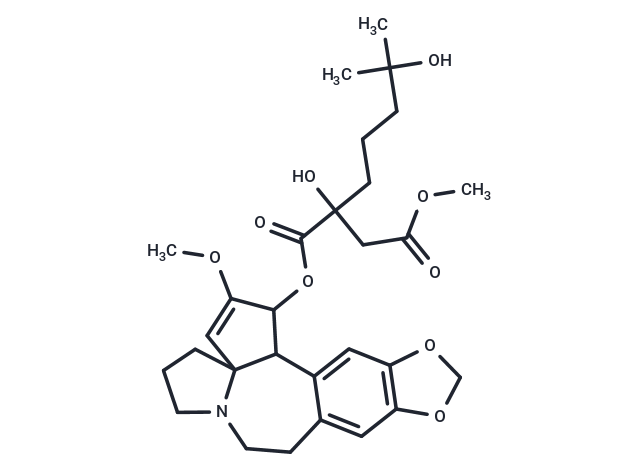Shopping Cart
- Remove All
 Your shopping cart is currently empty
Your shopping cart is currently empty

Homoharringtonine (HHT) is a natural alkaloid that inhibits the translation of proteins and is cytotoxic. Homoharringtonine acts on the ribosomes of tumor cells to inhibit the elongation step of protein translation, thereby inhibiting protein synthesis, and has antitumor activity.

| Pack Size | Price | Availability | Quantity |
|---|---|---|---|
| 5 mg | $50 | In Stock | |
| 10 mg | $77 | In Stock | |
| 25 mg | $123 | In Stock | |
| 50 mg | $219 | In Stock | |
| 100 mg | $313 | In Stock | |
| 1 mL x 10 mM (in DMSO) | $68 | In Stock |
| Description | Homoharringtonine (HHT) is a natural alkaloid that inhibits the translation of proteins and is cytotoxic. Homoharringtonine acts on the ribosomes of tumor cells to inhibit the elongation step of protein translation, thereby inhibiting protein synthesis, and has antitumor activity. |
| In vitro | METHODS: Human lung cancer cells A549 and NCI-H1975 were treated with Homoharringtonine (1-6 µM) for 24-48 h. Cell viability was measured by MTT assay. RESULTS: Homoharringtonine was moderately cytotoxic to A549 with an IC50 of 3.7 µM. H1975 cells were more sensitive to Homoharringtonine with an IC50 of 0.7 µM. [1] METHODS: Melanoma cells A375 and B16F10 were treated with Homoharringtonine (100 nM) for 48 h. Cell cycle and apoptosis were detected by Flow cytometry. RESULTS: Homoharringtonine induced apoptosis and G2/M cell cycle arrest in A375 and B16F10 cells. [2] |
| In vivo | METHODS: To detect anti-tumor activity in vivo, Homoharringtonine (10 mg/kg) was intraperitoneally injected five times a week for three weeks into nude immunodeficient mice harboring human lung cancer tumor H1975. RESULTS: Homoharringtonine effectively inhibited tumor growth, and STAT3 phosphorylation and MCL1 levels were significantly reduced in the Homoharringtonine-treated group. [1] METHODS: To investigate the antitumor activity in vivo, Homoharringtonine (0.7 mg/kg) was administered by gavage to NOD/SCID mice bearing ccRCC tumor grafts twice daily for 28 days. RESULTS: Two tumor graft lines, XP26 and XP144, showed observable tumor growth inhibition following Homoharringtonine treatment. For XP26 tumors, tumor growth was inhibited by 63.7% in Homoharringtonine-treated mice compared to vector-treated mice, while tumor growth was inhibited by 43.0% in XP144 mice. [3] |
| Cell Research | Homoharringtonine (HHT) is dissolved in PBS at a stock solution of 2.5?mM and kept at ?20°C[1]. Human NSCLC cell lines MCF-10A, A549 and H1975 cells are seeded into 96-well plate and precultured for 24?h, then treated with Homoharringtonine for 24?h or 48?h. Cell cytotoxicity is determined by MTT assay. The absorbance is measured at 570?nm by Varioskan Flash Multimode Reader, and the cell death rate is calculated. Cell viability is estimated by trypan blue dye exclusion assay. The cells which exclude the dye are viable. Place 0.5?mL of a suitable cell suspension (dilute cells in complete medium without serum to 1×106 cells per mL) following adding 0.1?mL of 0.4% trypan blue dye and mixing thoroughly, and then incubate at room temperature for 3?min and load into a hemacytometer to count cells in three separate fields (nonviable, deep blue cells as well as viable, clear cells). The cell viability rate is calculated. After staining with Hoechst 33258 at 10?mg/mL for 10?min, cell death is observed by a fluorescence microscope[1]. |
| Alias | Omacetaxine mepesuccinate, Myelostat, HHT, Ceflatonin |
| Molecular Weight | 545.62 |
| Formula | C29H39NO9 |
| Cas No. | 26833-87-4 |
| Smiles | COC(=O)CC(O)(CCCC(C)(C)O)C(=O)OC1C2c3cc4OCOc4cc3CCN3CCCC23C=C1OC |
| Relative Density. | 1.33 g/cm3 |
| Storage | Powder: -20°C for 3 years | In solvent: -80°C for 1 year | Shipping with blue ice. | |||||||||||||||||||||||||||||||||||
| Solubility Information | 5% DMSO+95% Saline: 4.55 mg/mL (8.34 mM), In vivo: Please add co-solvents sequentially, clarifying the solution as much as possible before adding the next one. Dissolve by heating and/or sonication if necessary. Working solution is recommended to be prepared and used immediately. DMSO: 50 mg/mL (91.64 mM), Sonication is recommended. Chloroform, Dichloromethane, Ethyl Acetate, Acetone, etc.: Soluble | |||||||||||||||||||||||||||||||||||
Solution Preparation Table | ||||||||||||||||||||||||||||||||||||
5% DMSO+95% Saline/DMSO
DMSO
| ||||||||||||||||||||||||||||||||||||

Copyright © 2015-2025 TargetMol Chemicals Inc. All Rights Reserved.